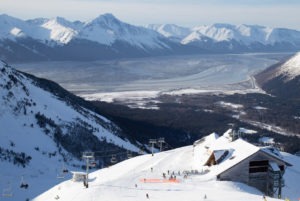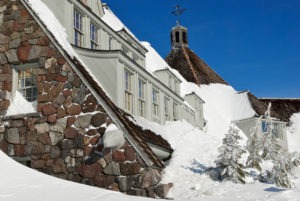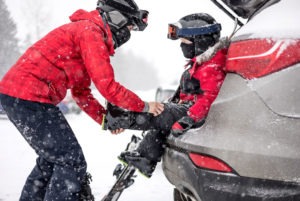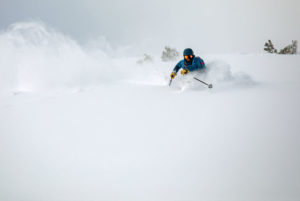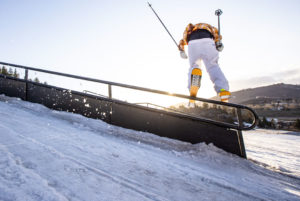Poetry In Motion
At the close of the 19th century, Europe sat in the oily puddle of the Industrial Revolution. London and Paris were overcrowded, mechanized, smog-filled; dreary. Earth-shattering advancements had forever changed the course of humanity and the human condition; but at what cost? It is arguable a great disservice was executed upon the human spirit. A disconnection with the natural world and one’s fellows arose through the machine of modernization. French art and literature had an emotional reaction which spawned Romanticism, the Decadent Movement, and the Fin de Siècle. Over the course of 100 years, these movements tried to grasp that which was not present: “freedom” (in its many definitions), a call to nature, emotions, vitality; spirit.
At the same time, skiing in France was being reexamined. Traditionally seen as a means of transportation in snowbound regions and a winter tool for soldiers and hunters; skiing was transforming into sport and recreation. Mirroring the artistic movement for connectedness, skiing brought inclusive synergy to the disjointed and dispirited masses. In 1907, a young carpenter and skier named Abel Rossignol created a pair of wooden skis with a light varnish which changed the course of the ski industry and culture forever. The underlying current which permeated the stream of European culture was overly pessimistic and bored. Lethargy, apathy, and spiritual inactivity ruled the day. Rossignol aimed to dam the river and begin anew, to reconnect with the natural world and the soul.
In French, Rossignol translates to nightingale; a bird which is a hallmark of influence on art and poetry. Not only has the nightingale been a long standing subject of poetry, it has served as its muse as well.
“A poet is a nightingale who sits in darkness and sings to cheer its own solitude with sweet sounds; his auditors are as men entranced by the melody of an unseen musician, who feel that they are moved and softened, yet know not whence or why.” Shelley, “A Defense of Poetry”
The songbird has a seemingly spontaneous and creative ballad, amplified by and in the cogs of the urban environment. The males sing at night and again in the hour before dawn. The trills build to crescendo, signifying an end with a celebratory recognition of a future. It is an anthem. This inventive hymn echoed within the creative genius of Abel Rossignol in the early 1900’s and continues to resonate in the annals of permutation in the Rossignol Ski Company in 2014. It is the banner which waves in the winds of Rossignol’s innovation. Rossignol, as ski company, has continued the Nightingale-esque creative imagination with their 2014 line of skis. They have branded themselves as an “icon of the past and a symbol of the future.” This mountain lifestyle brand has worked tirelessly to create perhaps the most innovative skis for the 2014 Season.
The ski tech in this years line serves as Rossignol’s Fin de Siècle, “the end of an era,” of tired and unrefined flash-in-the-pan concepts. Rocker technology has revolutionized the ski industry, improving flotation and turn initiation while reducing fatigue. Yet it has only half delivered on its promise of the best ride of one’s skiing life. As Proust lamented “we love only what we do not wholly possess,” a skier is in constant search of the untracked, perfect powder line. Rockered skis have been touted as the ultimate powder tool; yet the technology in design has birthed geometric harshness with drastic ill effects. A skier will know this as “noodling,” “chattering,” “bulldozing,” “a heavy push,”et cetera, depending on what one is skiing on or in. However, and as Proust points out: “The real voyage of discovery consists not in seeking new landscapes, but in having new eyes.” Rossignol has redefined the technology and offers two different types that serve as quintessence of rocker.
“True alchemy lies in this formula: ‘Your memory and your senses are but the nourishment of your creative impulse’.” Arthur Rimbaud, Illuminations
Rossignol’s Auto Turn Rocker is a re-imagining of the traditional ski profile. A gradual 30% tip and tail rocker smoothly progresses into the 70% cambered body of the ski. The result is unmatched precision and edge hold while on-piste with versatile performance and floatation when off-piste (The Experience 88 & 98 ). Auto Turn skis are among the most versatile for front side carving, mogul performance, with the ability to float in light powder.
The true genius of Rossignol’s call back to the creative spirit which burns deep within every skier is Powder Turn Rocker, most notably featured in the award winning 7-Series ( S7 Pro, Sin 7, Smash 7, Soul 7, Super 7, Squad 7). Powder Turn Rocker is a 50/50 split of traditional camber underfoot with tip and tail rocker which has a modest rise in profile from the binding heal and toe pieces toward the ends of the ski. Rossignol ski designers have worked with athletes and drawn upon their own skiing experience to remove the excessive and extreme silhouette but protract the brilliant flavor in the rocker recipe. The 7-Series features thick waists but the profile has modest, elongated geometry. A lengthened rocker shape allows the ski to plane within the deep snow rather than push itself on top. The turn therefore exists within the natural line, joined to to it in a surfy interconnection. It is the ultimate turning experience; the ultimate bond and soul enriching sensation within the natural medium.
“A thousand dreams within me softly burn” Rimbaud, Evening Prayer.
Rossignol’s ski construction tech in 2014 offers the answer to the ever-present desire for a ski which is torsionally rigid and performance-based, yet lightweight, playful, and allowing for freedom in ride. It is through Rossignol’s beautiful combination of function and creativity which provides such versatility, such skiing boldness. The newly developed and patented Air Tip Technology is a honeycomb construction which drastically cuts both the total weight of the ski as wells as its swing weight. This provides for the utmost maneuverability and quickness. A construction that eliminates material seems it would therefore lose strength. In fact the contrary exists. The tip and tail of skis featuring Air Tip are torsionally rigid and extremely tough.
This toughness does not give the ski a ride lacking in flavor or liveliness. Rather it adds a layer of confidence and efficiency to the pattern of freedom. The Light Wood Core is made up of Paulownia; a lightweight, low density wood which has an energetic rebound. Rossignol’s Race Department Diago Fiber is placed at specific angles buttressing the core of the ski while simultaneously adding more pop. The fluidity of the turn and travel into the next is strong, playful, and effortless. The Centered and Extended Sidecuts allow these turns to have an endless amount of differing shapes. The result of all this tech is an incredible ski and ski experience which can be pushed to the limits of both the skiers skill level and creative expanse.
Rossignol has produced quite the feat in 2014. The French love affair with skiing is as passionate as the poetry birthed from the grayness of the Industrial Revolution. A call to nature, a call to the brilliance of creative passion existed with both skiing and art under the shadows of industrialization, within the mire of mechanization. Abel Rossignol answered that call in 1907 and Rossignol still answers it today. The songbird sings out in glorious triumph. The 2014 line of skis is its epic, its opus. The technology in ski profile and construction reconnects the skier to the glory of the mountain and amplifies one’s interaction through poetic design and artful conception. Abel was the idealized poet and Rossignol is the creative expressor. In 2014, the skier is allowed poetic license and a bounty of creativity all steeped in performance. The ski is the pen, the line is the verse, the experience is the muse.






